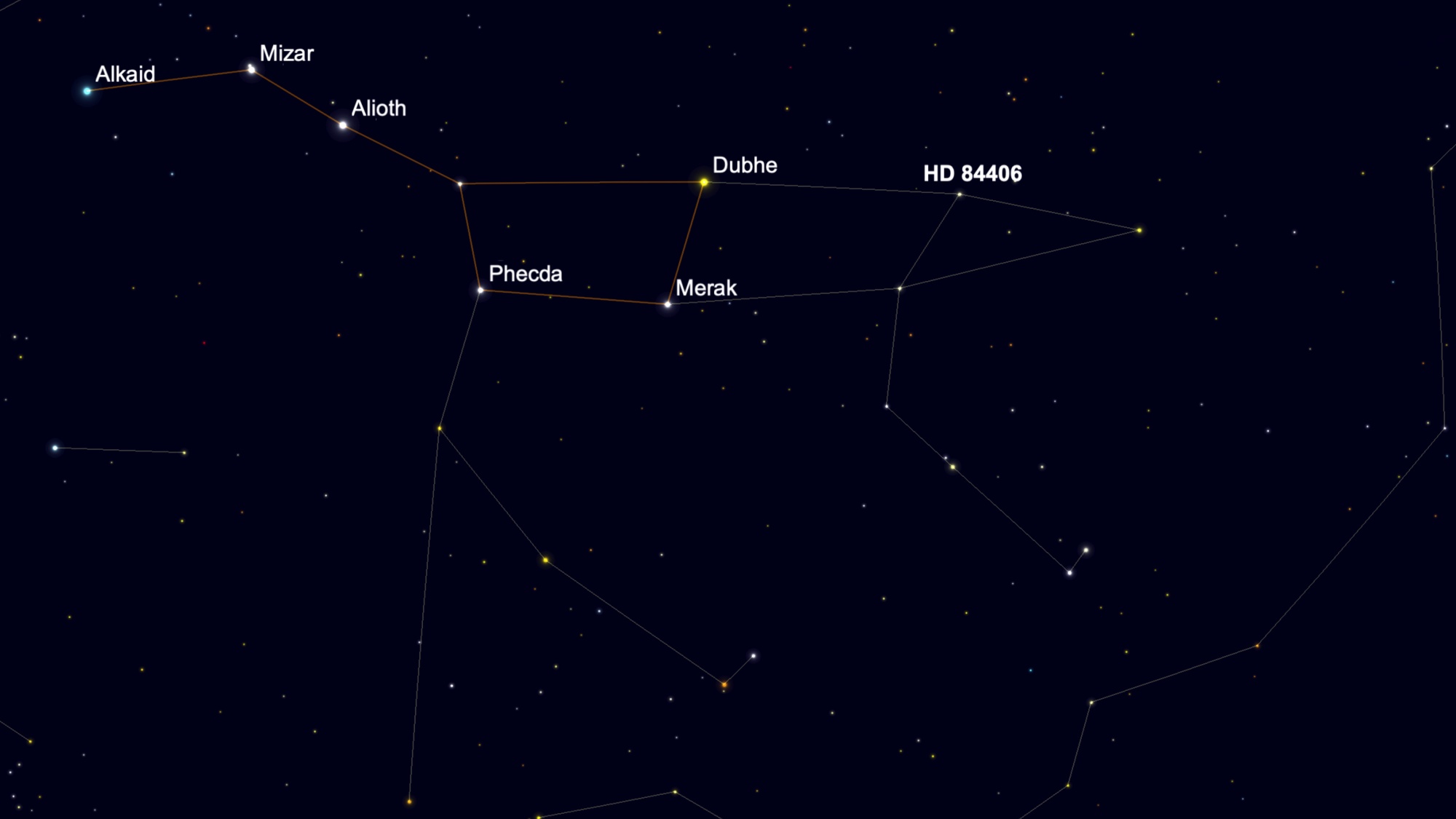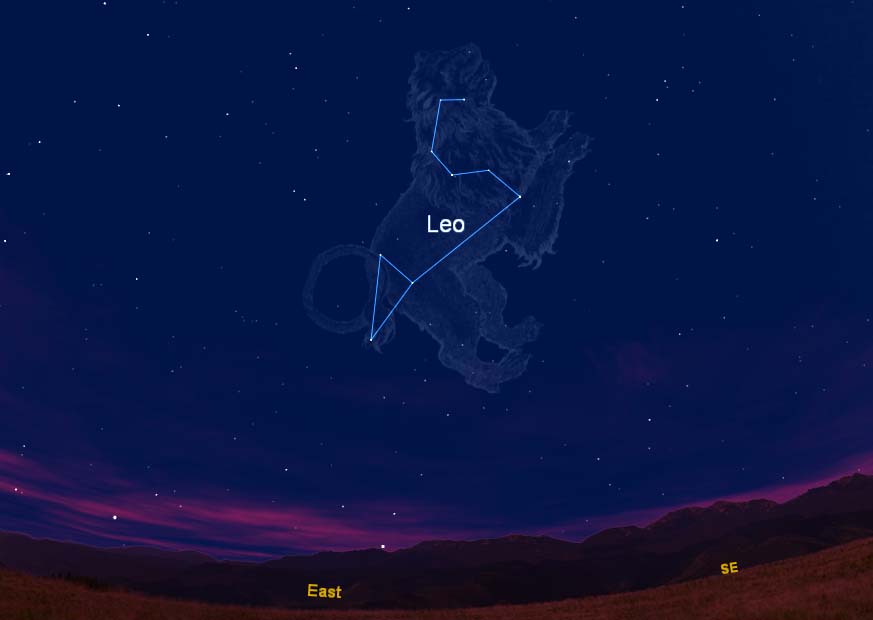From Leaping Leo to the Big Dipper: Here’s how to see the bright stars of spring rising in the east this season
The constellations march ever westward from month to month, with old ones disappearing into the sunset as new ones rise in the east.
This is because the stars run like clockwork on a specific schedule. Thanks to the fact that our Earth rotates on its axis once every 23 hours and 56 minutes, a star — any star — rises and sets four minutes earlier every day than it did the day before. This motion means that any given array of constellations will appear in the same location of the sky two hours earlier each month. So, the celestial scene you witnessed by staying up until 11 p.m. in mid-April is already there at dusk in mid-May.
At this time of year, as the last of the bright patterns of winter decline in the west, the milder stars of spring have ascended to dominate our southern and eastern skies. For those of us living in the cities, surrounded by smoke and haze and bright lights, it becomes easy to overlook the beauty of the night. For seldom do we travel out into the country, far from the lights of humanity to enjoy this grandeur.
Our distant ancestors, however, had no such concerns; they could see the sky at night perfectly from wherever they were. Their imaginations were not weakened by pictures in newspapers and magazines, movies or television. The night sky provided their sole entertainment, and they weaved stories filled with imagination, using patterns of stars for illustration.
These patterns — the constellations — are the legacy of their imagination; the constellations that we know have their origins in the eastern Mediterranean and the Middle East, thanks to the ancient Greeks and Romans. These constellations (plus some modern ones) are now accepted everywhere in the West.
But what about traditional cultures in the rest of the world? Interestingly, the night sky contains a number of star patterns so striking that almost every culture in the world has recognized them. Several of them occupy our current spring sky. Probably the most famous is positioned almost directly over our heads this week as darkness falls: the Big Dipper.
Origin of the Big Bear
Officially, the Dipper is not a full-fledged constellation, but an asterism — just a part of the constellation known as Ursa Major, the Great Bear. And indeed, Ursa Major is a big bear. Along with the seven stars that compose the Big Dipper, its surrounding stars sprawl across a whole quadrant of the sky. In area it’s the third biggest constellation, behind Hydra the Water Snake and Virgo the Maiden.
Interestingly, the ancient Greeks associated the seven stars of the Big Dipper with a bear long before they added the surrounding stars to complete the picture of a ferocious animal with a head and paws some two millennia ago. But what made the Greeks think of a bear? The Dipper’s handle must be the bear’s long tail, yet bears possess short, stubby tails.
TOP TELESCOPE PICK:
See the night sky up close with the Celestron NexStar 4SE, an ideal telescope for beginners wanting quality, reliable and quick views of celestial objects. For a more in-depth look at our Celestron NexStar 4SE review.
The ancient Greek philosopher Aristotle (384-322 BC) believed that the bear was the only animal that could survive in the frigid north — indeed, our word “arctic” is derived from arctos, which is Greek for “bear.” By this logic, only a bear could inhabit the northern sky.
We can use the Big Dipper to find other familiar stars and constellations currently adorning our springtime sky. The two stars forming the outer end of the Dipper’s bowl, are known as the “pointer” stars and currently point straight down toward Polaris, the North Star, which is due north. The aim isn’t perfect but close enough. Polaris marks the end of the tail of Ursa Minor the Little Bear, or the handle of the Little Dipper, whose stars are quite faint, except the North Star and the two in the front of its bowl; these have been called the “Guardians” because they seem to march endlessly, like sentries circling the pole.

A spring landmark
At New York’s Hayden Planetarium, we would ask our audiences to imagine that the bowl of the Dipper was filled with water. “Now, imagine if we poked a hole in the bottom of the bowl and let the water spill out. Who would get wet?” With our electric pointer, we’d then follow the imaginary flow of water down to a pattern of stars composed of a triangle and a backward question mark shape that’s about 1½ fist-widths at arm’s length tall. This is the “Sickle” that marks the head and mane of Leo the Lion.
The Sickle is a landmark of the spring skies; it’s composed of six stars, the brightest of these is Regulus, a blue-white first magnitude star, 79 light years away which marks the base of the Sickle. The pointer stars of the Big Dipper point in one direction to the North Star; in the other direction to the triangle that makes up the lion’s hind quarters and tail.

The Bear Driver
Going back to the Big Dipper, if we follow the curve of the Dipper’s handle past its end star for about 30 degrees (“three fists”), you’ll come to a brilliant star — in rank, the fourth brightest in the sky — which shines with a distinct orange hue known as Arcturus, in Boötes the Herdsman. The other stars of Boötes are much fainter, of third and fourth magnitude. Most of them form a kite-shaped figure extending close to the Dipper’s handle, although my personal preference is to visualize Boötes as an ice cream cone.
Arcturus (at a magnitude of -0.05), one of the few stars mentioned by name in the Bible, is a giant, about 25 times the diameter of our sun and 36.7 light years away. Boötes is chasing the Bears with a pair of Hunting Dogs (Canes Venatici), which makes a small constellation between Arcturus and the Dipper’s bowl.

America’s Star?
If we continue to follow the arc of the Big Dipper’s handle past Arcturus, we eventually will “speed to Spica,” the brightest star of Virgo the Maiden. Spica is a blue-white first magnitude star 250 light-years away.
The year 2026 marks the 250th anniversary of the United States; it is interesting to note that the light from Spica that started on its journey toward Earth at the time that the Declaration of Independence was ratified in 1776, will finally arrive next year.
An opportunistic stellar omnivore
Just to the right of Spica, the most striking star pattern in the spring skies next to Leo’s Sickle is a little four-sided figure of fairly bright stars, resembling a triangle whose top has been removed by a slanting cut. Like most of the constellations it bears little resemblance to the object it is supposed to represent: Corvus the Crow.
Just follow the direction of its slanting top toward the left (east) and you will soon comet to Spica. In the old allegorical star atlases, Virgo is holding a spike of wheat where Spica glows, evidently representing the harvest time which occurs in mid-October when the sun is passing that bright star. And apparently, Corvus is lying in wait to snatch the wheat from out of Virgo’s hand!
At least that’s the story.
Plenty of bright stars … plus two planets
At this time of the year, eleven first magnitude stars are in the sky simultaneously as the sky darkens. Brilliant Sirius, a winter luminary and the brightest of all the stars, is disappearing in the west-southwest, while Deneb, a star of the summer season, is just beginning to peek above the north-northeast horizon. And our spring evening sky is also augmented with two bright planets. Low in the west-northwest is brilliant Jupiter, which will remain in view for another few weeks before it vanishes into the bright evening twilight.
And much higher in the southwest sky glows Mars. Currently located against the dim stars of Cancer, on June 17 — just a few days shy of the official end of spring — it will call attention to itself in the west after dusk by forming a striking “double star” with Regulus. The planet will be just a trifle dimmer than the star but their proximity intensifies the orange-yellow of Mars and the blue-white of Regulus.
Joe Rao serves as an instructor and guest lecturer at New York’s Hayden Planetarium. He writes about astronomy for Natural History magazine, Sky and Telescope and other publications.
Source link






